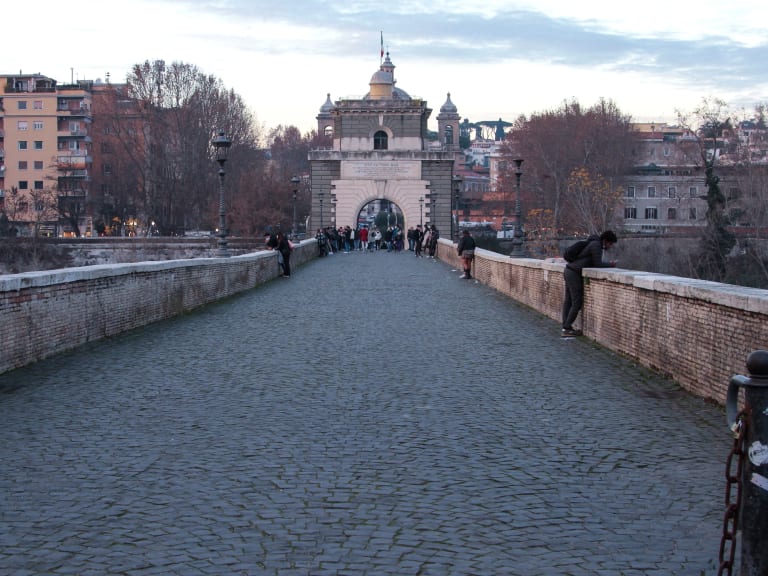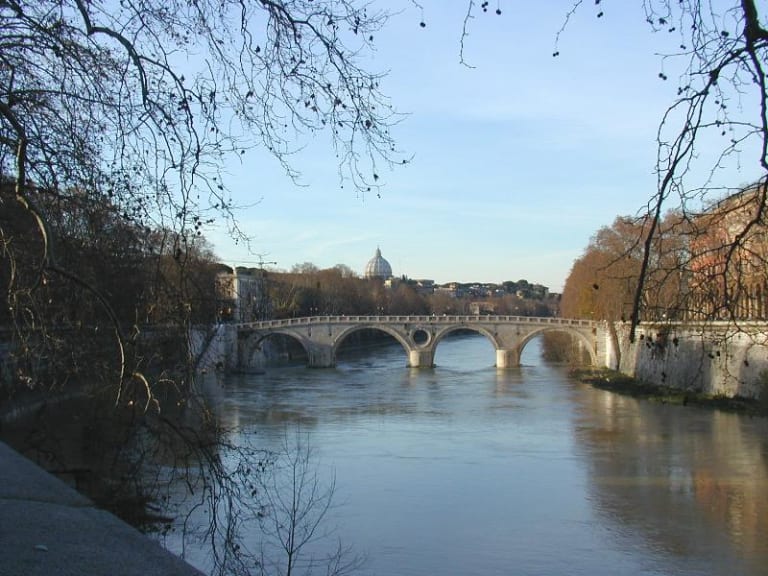10 Rome's Best Bridges
Beautiful and practical, these are Rome's bridges that connect the different parts of the city. Don't miss them!

Bridge in Rome | ©Olga Lioncat
The Tiber River divides Rome in half and to connect the two banks, the city is dotted with a multitude of bridges from different eras and styles. From many of them there are amazing views of the Eternal City, so if you want to enjoy them during your trip, I encourage you to take note of these 10 bridges in Rome that will surprise you.
1. Castel Sant'Angelo Bridge

The Sant'Angelo Bridge connects the Ponte and Borgo neighbourhoods and is one of the oldest and most beautiful bridges in Rome.
It gives access to Castel Sant'Angelo (a vestige of the city's imperial era) and is located very close to the Vatican, which is why it was the bridge most pilgrims crossed to reach St. Peter's Basilica.
In the 2nd century AD, Emperor Hadrian ordered the construction of the Bridge of Sant'Angelo to link it with the mausoleum he was also building on the right side of the Tiber River. The three central arches remain from that period, but the rest of the bridge is a later modification, for example the angels that decorate it.
These sculptures were commissioned by Pope Clement IX from the artist Gian Lorenzo Bernini, although more people were involved in the project. Of the acclaimed sculptor there are really only two (the angels with the crown of thorns and with the sign "INRI") which are preserved today in the church of Sant'Andrea delle Fratte.
To fully enjoy the beauty of the Bridge of Sant'Angelo I recommend you visit it at sunset, when the last rays of the sun are reflected on the water of the Tiber River.
- Address: Lungotevere Castello, 50.
- How to get there: By bus, lines 23, 34, 49, 64 and 87.
2. Milvio Bridge

The Milvian Bridge is another of the oldest bridges in Rome that I recommend you to visit. On the one hand, it had a crucial importance in the history of the Roman Empire since the battle of the Milvian Bridge took place in its surroundings in the 3rd century A.D. where the emperors Maxentius and Constantine clashed for power. With the victory of Constantine carrying the Christian banner, the history of Rome and Western civilisation changed forever.
On the other hand, in popular culture the Milvian Bridge is famous for the novel "Forgive me if I call you love" by Federico Moccia as the place where the protagonists seal their love by putting a padlock on the bridge and throwing the key into the Tiber.
If you travel with your partner to the Eternal City, I recommend you to visit the Milvio Bridge as it is one of the most emblematic romantic places in Rome.
- Address: Ponte Milvio, 00196 Rome.
- How to get there: By bus, line 32, stop Marshal Diaz - De Bosis.
3. Sisto Bridge

The present bridge was built on the ruins of an ancient Roman bridge erected by Emperor Caracalla in the 2nd century AD, the Bridge of Agrippa. Later Pope Sixtus IV ordered the construction of this bridge to facilitate the passage of pilgrims to the sacred spaces of the city.
I recommend you visit it because from the Sisto Bridge you will have beautiful views of the Vatican with the Dome of St. Peter's in the distance, as well as the charming district of Trastevere and the rest of the bridges that cross the Tiber.
- Address: Piazza Trilussa, 00153 Roma
- How to get there: By bus, lines 23, 62, 81, 280 and 492.
4. Umberto I Bridge

The Umberto I Bridge doesn't appear in many guidebooks but it's one of Rome's must-see bridges because from here you can get some of the best pictures of your Rome getaway.
This bridge connects Piazza di Ponte Umberto I with Piazza dei Tribunali and is located very close to Castel Sant'Angelo and Piazza Navona (an elegant baroque square that I recommend you to explore especially during its Christmas market).
The views of Rome at dusk from this 19th century bridge are some of the most beautiful, with the whole landscape illuminated: St. Peter's Basilica, the Sant'Angelo Bridge and the Tiber River - a marvellous sight!
- Address: Ponte Umberto I, Rome.
- How to get there: By bus, lines 30, 70, 81, 87, 130, 280, 492 and 628.
5. Rotto Bridge

What is known today as the Ponte Rotto many centuries ago was the Ponte Aemilius, Rome's first stone bridge.
It was built back in the 2nd century AD and once connected the Trastevere district and the Foro Boarium. It stood until a great flood in the 16th century swept away the eastern part of the bridge, leaving it "broken".
It was never completely rebuilt and at the end of the 19th century it was decided to demolish the western part, leaving a single arch in the middle of the riverbed. Stand on the Palatine Bridge to take the best pictures of it!
- Address: Lungotevere degli Alberti: Lungotevere degli Alberteschi, 00153 Rome.
- How to get there: By bus, lines 30, 81, 83, 85, 160 and C3.
6. Palatine Bridge

To replace the ill-fated Ponte Rotto and connect the Foro Boario with the Trastevere district, the Palatine Bridge was designed in the 19th century. It takes its name from the Palatine Hill on the slopes of which it is built.
- Address: Lungotevere degli Alberteschi, 00153 Rome.
- How to get there: By bus, lines 30, 81, 83, 85, 160 and C3.
7. Fabricius Bridge

Among all the bridges in Rome, the Fabricius Bridge, the oldest in the city, was built in the 1st century A.D. to connect the Tiber Island with the Field of Mars on the east side.
Crossing such an ancient bridge is quite a sight. Although some more recent alterations have been made to the bridge, the structure, the central core and the tufa arches are original. Look at the arches of the bridge! They have one of the oldest inscriptions in Rome mentioning the builder of the bridge: Lucius Fabricius.
- Address: Lungotevere dei Pierleoni
- How to get there: By bus, lines 30, 81, 83, 85, 160 and C3.
8. Vittorio Emanuele II Bridge

Every bridge in Rome has its charm and the Vittorio Emanuele II Bridge is no exception. It is one of the most beautiful bridges in the city and is full of sculptures and artistic details.
Designed in the 19th century, its construction was delayed and it was not inaugurated until the beginning of the 20th century. In this way this point of the river Tiber regained the passage it once had with the Bridge of Nero, which was erected during the Imperial period and of which you can still see certain vestiges in the surrounding area.
In itself, the Vittorio Emanuele II Bridge is worth a visit because it is very beautiful although I also advise you to visit it because from it you will have fantastic views of both the Bridge and the Castel Sant'Angelo and the dome of St. Peter's in the distance.
- Address: Lungotevere dei Fiorentini, 00186 Rome.
- How to get there: By bus, lines 23, 34, 49, 64 and 87.
9. Queen Margherita Bridge

After visiting the Pincio Terrace (one of Rome' s most beautiful parks ) and the Piazza del Popolo I recommend you head to the Queen Margaret Bridge, located very close to these tourist attractions, to enjoy one of the best views of the Tiber River.
Unlike some of Rome's other bridges, it's not as lavishly decorated as other bridges, but its simplicity is its charm. It is dedicated to Margherita of Savoy, the first queen of Italy, and connects Piazza del Popolo with the Prati district.
- Address: Queen Margherita Bridge, Rome.
- How to get there: By bus, lines 89, 628, 120 F and 150 F.
10. Music Bridge

The Ponte della Musica is one of the most modern bridges in Rome both for its date of construction (beginning of the 21st century) and for its futuristic appearance. It was erected with the aim of linking the Flaminio neighbourhood with the Delle Vittorie neighbourhood.
If you fancy seeing a bridge that is different from the rest of Rome's bridges, I recommend you visit it while taking advantage of a visit to the Foro Italico.
- Address: Lungotevere Maresciallo Cadorna, Rome.
- How to get there: By bus, lines 32, 280, 301 and 628.
